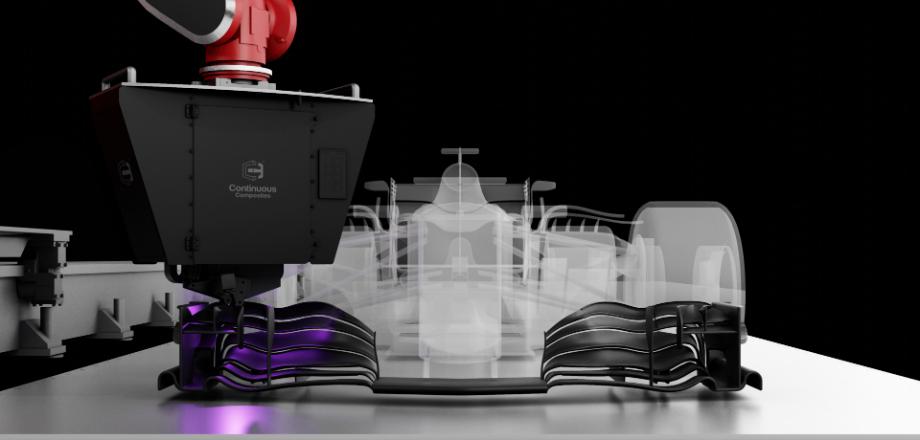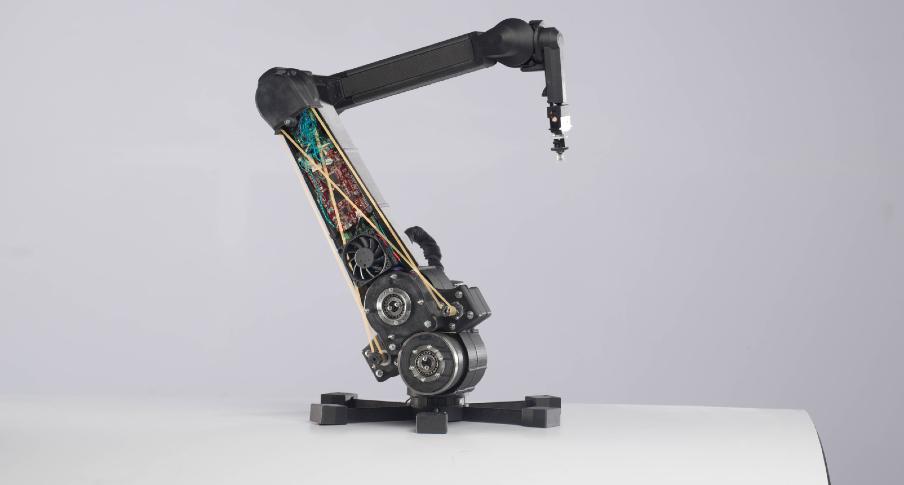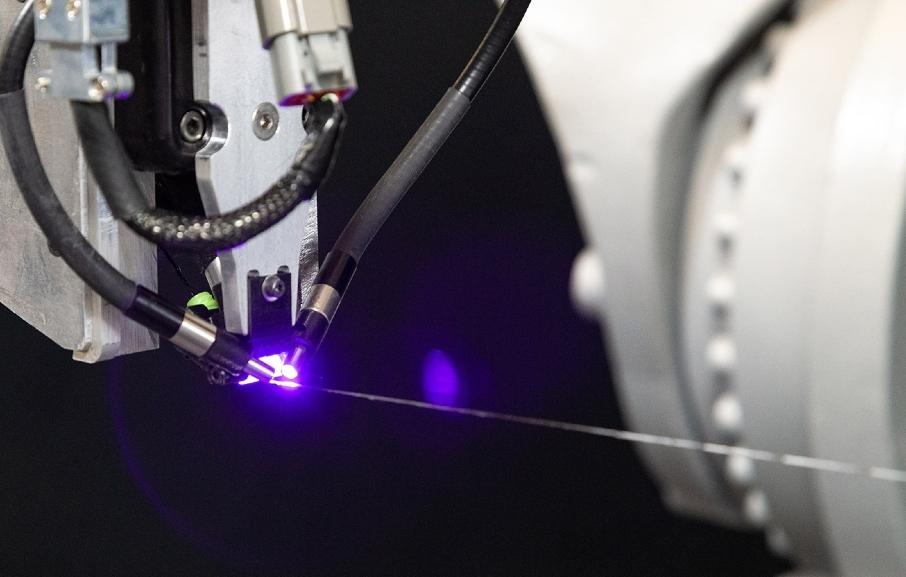- FMA
- The Fabricator
- FABTECH
- Canadian Metalworking
Our Publications
Categories
- Additive Manufacturing
- Aluminum Welding
- Arc Welding
- Assembly and Joining
- Automation and Robotics
- Bending and Forming
- Consumables
- Cutting and Weld Prep
- Electric Vehicles
- En Español
- Finishing
- Hydroforming
- Laser Cutting
- Laser Welding
- Machining
- Manufacturing Software
- Materials Handling
- Metals/Materials
- Oxyfuel Cutting
- Plasma Cutting
- Power Tools
- Punching and Other Holemaking
- Roll Forming
- Safety
- Sawing
- Shearing
- Shop Management
- Testing and Measuring
- Tube and Pipe Fabrication
- Tube and Pipe Production
- Waterjet Cutting
Industry Directory
Webcasts
Podcasts
FAB 40
Advertise
Subscribe
Account Login
Search
Continuous fiber 3D printing takes AM in new directions
Replacing machined metal components with lighter, cheaper 3D-printed parts
- By Kip Hanson
- April 7, 2020
- Article
- Additive Manufacturing

Continuous Composites’ CF3D combines the power of composite materials with rapid-curing resins to create a moldless, out-of-autoclave manufacturing process. It prints structural and functional fibers in free space. Continuous Composites
Despite additive manufacturing’s enormous potential and the unprecedented design freedom and flexibility it offers, AM is subject to one inherent weakness: anisotropy, or the tendency of an object to exhibit different mechanical properties along different axes.
That’s because most 3D printing technologies involve building parts in layers, making the Z-axis (vertical) strength of those parts less than the horizontal X- and Y-axis layers.
Granted, the differences often are minimal, and cracking and delamination are not the problems they once were thanks to improved process control, knowledgeable design practices, and greater availability of build-friendly materials. Yet the fact remains that 3D-printed parts typically exhibit greater strength when application forces are applied parallel to the direction of the layers than perpendicular to the layers.
At the same time, designers continually strive to design AM parts that are both lighter and stronger than conventionally manufactured ones, and this means an increased emphasis on plastics and composite materials. But the parts produced by mainstream polymer-based processes, such as fused deposition modeling and selective laser sintering, tend to suffer the most from anisotropy.
This creates a Catch-22 tradeoff of strength versus weight.
Adding Fiber
There is a way to get your 3D-printed cake and eat it too. It’s called continuous fiber 3D printing, and it’s poised to change the way we design and manufacture parts. (Again!)
Imagine a material that, compared to aluminum, offers a 20% greater yield strength and double the tensile strength, yet weighs half as much. Now imagine all that you could do with such a material. That’s the promise of continuous carbon-fiber printing.
There’s also continuous aramid-fiber printing, fiberglass, and a whole host of composite materials, all of which can be used to build parts that are both lighter and stronger—in any direction—than those made by powder, resin, and even metal 3D printers.
The not-quite-new technology is called continuous filament fabrication, or CFF—a technology that inventor Markforged Inc. suggests builds some of the strongest, most versatile parts possible with a 3D printer.

Additive manufacturing allowed Haddington Dynamics to reduce the number of parts in its Dexter robot arm from 800 to fewer than 70. The 7-axis, fully assembled arms are made from a continuous carbon-fiber-reinforced material. Markforged
On the Mark
“Our Mark Two, X7, and other continuous fiber printer models deliver three things,” said Joe Roy-Mayhew, director of materials at Markforged, Watertown, Mass. “First, the surface quality is fantastic, so much so that you’d have trouble telling if the parts coming off of them were injection-molded or 3D-printed. The second is mechanical strength, which is generally an order of magnitude higher than you would realize from competing technologies. And the third is simplicity, in that users can basically just hit the print button and come back an hour or two later to functional, end-use parts.”
On the surface, Markforged’s CFF printers look and act much like any other filament-style machine. What’s different is the addition of a continuous filament of hundreds of strands of reinforcing material per layer.
As Roy-Mayhew explained, the system is equipped with two nozzles—one for depositing the nylon or other plastic fill and one for the carbon fiber, Kevlar, or fiberglass-reinforcement strands. After the initial fill operation, the strands are “ironed” into place wherever needed—around the part perimeter, for example, or tracing the outsides of holes and bosses for additional strength.
Roy-Mayhew concedes that CFF parts are not isotropic, and their Z-axis strength is not equal to that of the horizontal plane. That said, he and the Markforged team have found that most parts—additively manufactured or not—do not experience stress and strain from all directions, and that the functionality and strength of any workpiece depend as much on the design as the materials used to produce it.
Free Space 3DP
Markforged is not alone in the continuous fiber world. Luxembourg-based Anisoprint offers a continuous fiber printer, as does Desktop Metal with its tape-based Fiber system.But if you want to see an entirely novel approach to composite-material AM, you’ll have to journey to Coeur d’Alene, Idaho, home of Continuous Composites Inc. and its CF3D (continuous fiber 3D) printing technology.
It’s there that fans of the HBO series Westworld will see a technology eerily reminiscent of that used to build the show’s robotic inhabitants (see Sidebar). CEO Tyler Alvarado described his company’s technology as “definitely a very different approach to 3D printing.”
It relies on a continuous composite feedstock and “snap curing” thermoset resin to produce parts with mechanical properties far superior to those made of thermoplastics, which, as Alvarado noted, is the most common type of AM.
“Our self-contained printhead can be mounted on a gantry system or robotic arm, so it is virtually unlimited in terms of the size of workpiece” it can build, he said. “It is then steered through free space, simultaneously extruding dry fiber material, impregnating it in-situ with a thermoset resin, and then curing it in place with a high-intensity energy source. This means a part can hold its shape completely unsupported and also be constructed in three dimensions at once rather than the traditional, layer-based approach.”
It’s an exciting concept, to be sure, yet Continuous Composites has its sights set on far more than structurally robust 3D-printed parts. Because it can print multiple “lanes” of material at once, it competes with the tape-based AFP (automated fiber placement) machines used to make aircraft structures, while eliminating the need for bulky layup tools and expensive postbuild curing processes.
And as Alvarado demonstrated during a recent TED Talk, it also allows the introduction of copper and Nitinol wire into the workpiece, opening doors to sensor-equipped, electrically conductive 3D-printed smart structures.
“We were frustrated with the three shortcomings of virtually all additive manufacturing processes, which are weak materials, slow print speeds, and small build volumes,” said Alvarado. “Our technology addresses all of these and more.”
SIDEBAR
Technology brings to mind opening for futuristic TV series
Have you seen the introduction for the HBO series Westworld? It features a futuristic 3D printer extruding stringers of robot-making material in a process that resembles Continuous Composites’ continuous fiber 3D technology.

JJ Churchill inspects every blade of the jet engine turbines it manufactures. The company prints fixtures for its CMM from continuous fiber-reinforced nylon. Markforged
It’s pretty cool stuff. During a recent interview, company CEO Tyler Alvarado didn’t mention anything about printing despotic robots, although he did explain how his technology relies on friendly industrial robots to deposit strands of “snap-cured” composite feedstock.
Such technology might soon compete with fiber-laying machines currently used to build commercial aircraft, he said. It could be used to build boats and cars and sporting goods. And because fiber-optic or electrically conductive materials can be interwoven with the fiber composites, these 3D-printed structures can also be made smart.
Maybe not Westworld robot smart—not yet, anyway—but smart enough to improve today’s conventionally manufactured structures and products.—K. Hanson
About the Author

Kip Hanson
About the Publication
- Podcasting
- Podcast:
- The Fabricator Podcast
- Published:
- 04/16/2024
- Running Time:
- 63:29
In this episode of The Fabricator Podcast, Caleb Chamberlain, co-founder and CEO of OSH Cut, discusses his company’s...
- Trending Articles
- Industry Events
16th Annual Safety Conference
- April 30 - May 1, 2024
- Elgin,
Pipe and Tube Conference
- May 21 - 22, 2024
- Omaha, NE
World-Class Roll Forming Workshop
- June 5 - 6, 2024
- Louisville, KY
Advanced Laser Application Workshop
- June 25 - 27, 2024
- Novi, MI




























